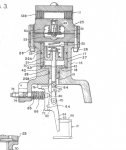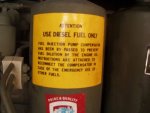Cole, how is this for an explanation:
The fuel viscocity compensator is located on the top rear portion of the IP.
A piston within the unit moves in accordance with the fuel pressure acting on it. The fuel pressure in turn varies as its viscocity varies. A lighter fuel (gasoline) will produce a lower pressure as some of the less viscous liquid will easily bypass the piston. A heavier fuel (diesel #2), will produce a higher pressure as less is bypassing the piston.
The piston sets the maximum fuel delivery to the injection pump.
The end result is that a fuel with lower heating value (BTU/gallon) will be delivered in higher quantity keeping the power output of the engine constant for a given position of the throttle.
The size of the orifices will change as the temperature of the fuel changes, so heating the fuel to lower the viscocity wil not alter the end result.
This works well for the four fuels specified in the manuals, diesel #2, Diesel #1, kerosene and gasoline. For these fuels, the BTU/gallon is directly proportional to the viscosity of it.
A common misconception is that ANY fuel can now be used and since the engine has a FDC the power output stays constant. Not so, biodiesel, for example has a lower heating value than diesel #2, but is more viscous, therefore the FDC works against biodiesel, delivering less fuel when it actually should deliver more for a constant power output.
Hoping this will help,
Bjorn




